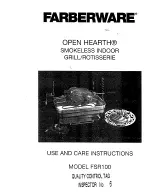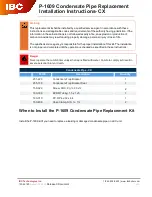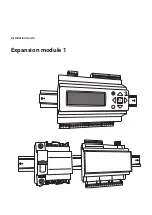
16
Example No. 2
Primary air suction from perimeter wall and
flue gas discharge from the same outside pe-
rimeter wall.
Maximum allowable load loss:
80 Pa
fig. 16
45
Hmin. = 165 mm
135
Min
200 mm
fig. 17
A
2
1
B
1
2
Installation info
CALCULATION OF PRESSURE LOSSES
FOR DISCHARGE AND SUCTION DUCTS
Bear in mind the following parameters when
calculating pressure losses:
-
for each metre of duct with Ø 80 (both
suction and discharge) the pressure loss
is 2 Pa;
-
for each 90° Ø 80 (R=D) bend with long
radius, the pressure loss is 2 Pa;
-
for each 90° Ø 80 (R=½ D) bend with
short
radius, the pressure loss is 6 Pa in
suction and 8 Pa in discharge;
-
for the Ø 80 L = 0.5 m horizontal air inlet
terminal, the pressure loss is 3 Pa;
-
for the Ø 80 L = 0.6 m horizontal
discharge end section, the pressure loss
is 5 Pa;
-
2 short radius 90° Ø 80 1
adapter Ø 80, the pressure loss is 14
Pa.
Example of check using wide radius
bends:
-
2 Ø 80 long radius 90° bends
+
1 adapter
Ø 80 =
(14 Pa)
-
29 mt duct Ø 80 x 2 =
(58 Pa)
NB: These values refer to di-
scharges through original UNI-
CAL non-flexible and smooth
ducts.
-
horizontal Ø 80 air inlet terminal =
3 Pa
-
horizontal Ø 80 terminal =
5 Pa
Tot. pressure loss = 80 Pa
2.2.10 - MEASUREMENTS OF
COMBUSTION EFFICIENCY
(Type A accessories)
Coaxial ducts
To determine combustion efficiency the fol-
lowing measurements must be made:
- the combustion air measured in hole
2
(see
fig. 17).
-
the flue gas temperature and CO2 measu-
red in hole
1
(see fig. 17).
(Type B accessories)
Dual ducts
To determine the combustion efficiency the
following measurements must be made:
-
the combustion air measured in
2
(see
fig. 17).
-
the flue gas temperature and CO2 measu-
red in hole
1
(see fig. 17).
Make these measurements with the boiler
running.
Smoke
Air
Analyser
probe
Analyser
probe
Analyser
probe
2.2.11 - CONNECTION TO THE
GAS MAINS
The supply pipe must have a section which is
the same as or greater than the one used in
the boiler.
Comply with the applicable installation
standards which shall be considered as
The seal test must be conducted using fuel
gas: use air or nitrogen.
When gas is flowing in the pipes, remem-
ber never to look for gas leaks using a
naked flame.
Use specific products found on the market
for the purpose.
having been incorporated in full in this
manual.
Before opening the internal gas distribu-
tion system; i.e. before connecting the gas
meter, all seals must be checked.
If any part of the system is concealed the
seals must be checked before the pipes are
covered.













































